Mostrar el registro sencillo del ítem
dc.contributor.author
Saavedra, Enzo Agustin

dc.contributor.author
Romero, Gustavo Esteban

dc.contributor.author
Bosch Ramon, Valentí

dc.contributor.author
Kefala, Elina
dc.date.available
2023-12-20T16:09:05Z
dc.date.issued
2023-10
dc.identifier.citation
Saavedra, Enzo Agustin; Romero, Gustavo Esteban; Bosch Ramon, Valentí; Kefala, Elina; Achromatic rapid flares in hard X-rays in the γ-ray binary LS I + 61 303; Wiley Blackwell Publishing, Inc; Monthly Notices of the Royal Astronomical Society; 525; 2; 10-2023; 1848-1855
dc.identifier.issn
0035-8711
dc.identifier.uri
http://hdl.handle.net/11336/220990
dc.description.abstract
We report on the presence of very rapid hard X-ray variability in the γ-ray binary LS I + 61 303. The results were obtained by analysing Nuclear Spectroscopic Telescope Array (NuSTAR) data, which show two achromatic strong flares on ks time-scales before apastron. The Swift/Burst Alert Telescope orbital X-ray light curve is also presented, and the NuSTAR data are put in the context of the system orbit. The spectrum and estimated physical conditions of the emitting region indicate that the radiation is synchrotron emission from relativistic electrons, likely produced in a shocked pulsar wind. The achromaticity suggests that losses are dominated by escape or adiabatic cooling in a relativistic flow, and the overall behaviour in hard X-rays can be explained by abrupt changes in the size of the emitting region and/or its motion relative to the line of sight, with Doppler boosting potentially being a prominent effect. The rapid changes of the emitter could be the result of different situations such as quick changes in the intra-binary shock, variations in the re-accelerated shocked pulsar wind outside the binary, or strong fluctuations in the location and size of the Coriolis shock region. Although future multiwavelength observations are needed to further constrain the physical properties of the high-energy emitter, this work already provides important insight into the complex dynamics and radiation processes in LS I + 61 303.
dc.format
application/pdf
dc.language.iso
eng
dc.publisher
Wiley Blackwell Publishing, Inc

dc.rights
info:eu-repo/semantics/openAccess
dc.rights.uri
https://creativecommons.org/licenses/by-nc-sa/2.5/ar/
dc.subject
RADIATION MECHANISMS: NON-THERMAL
dc.subject
STARS: NEUTRON
dc.subject
STARS: WINDS, OUTFLOWS
dc.subject
X-RAYS: BINARIES
dc.subject.classification
Astronomía

dc.subject.classification
Ciencias Físicas

dc.subject.classification
CIENCIAS NATURALES Y EXACTAS

dc.title
Achromatic rapid flares in hard X-rays in the γ-ray binary LS I + 61 303
dc.type
info:eu-repo/semantics/article
dc.type
info:ar-repo/semantics/artículo
dc.type
info:eu-repo/semantics/publishedVersion
dc.date.updated
2023-12-07T13:30:35Z
dc.journal.volume
525
dc.journal.number
2
dc.journal.pagination
1848-1855
dc.journal.pais
Reino Unido

dc.description.fil
Fil: Saavedra, Enzo Agustin. Universidad Nacional de La Plata; Argentina
dc.description.fil
Fil: Romero, Gustavo Esteban. Universidad Nacional de La Plata; Argentina. Provincia de Buenos Aires. Gobernación. Comisión de Investigaciones Científicas. Instituto Argentino de Radioastronomía. Consejo Nacional de Investigaciones Científicas y Técnicas. Centro Científico Tecnológico Conicet - La Plata. Instituto Argentino de Radioastronomía; Argentina
dc.description.fil
Fil: Bosch Ramon, Valentí. Universidad de Barcelona; España
dc.description.fil
Fil: Kefala, Elina. Universidad de Barcelona; España
dc.journal.title
Monthly Notices of the Royal Astronomical Society

dc.relation.alternativeid
info:eu-repo/semantics/altIdentifier/doi/http://dx.doi.org/10.1093/mnras/stad2377
dc.relation.alternativeid
info:eu-repo/semantics/altIdentifier/url/https://academic.oup.com/mnras/article-abstract/525/2/1848/7236870?redirectedFrom=fulltext
Archivos asociados
